The Water of Happiness Comes to Djibouti
By Hu Yifeng
[Ethiopia] Menda Zelele
In the Afar language spoken in easternmost Africa, Djibouti means “boiling pot”. This Horn of Africa country gets its name from its weather that is dry and hot all year round. Djibouti is in desperate need of fresh water. The total amount of water resources that can be recycled per capita is only 353.4 cubic meters per year, the lowest in all East African countries and below the international extreme water shortage standard of 500 cubic meters per year. Djibouti is one of the world’s most severely water-deficient countries.
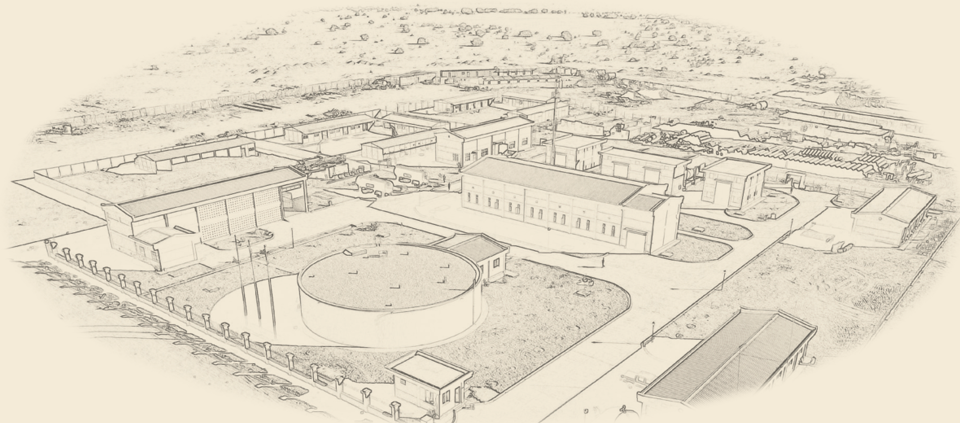
In the Afar language spoken in easternmost Africa, Djibouti means “boiling pot”. This Horn of Africa country gets its name from its weather that is dry and hot all year round. Djibouti is in desperate need of fresh water. The total amount of water resources that can be recycled per capita is only 353.4 cubic meters per year, the lowest in all East African countries and below the international extreme water shortage standard of 500 cubic meters per year. Djibouti is one of the world’s most severely water-deficient countries.
Djiboutians badly need clean drinking water. It is a serious issue for the government, which had been trying to find a source of fresh water but with little success.
Things changed in 2017, when the Djibouti-Ethiopia cross-border potable water project was finally completed. Led by the governments of Ethiopia, Djibouti and China, it was constructed by China’s CGCOC Group Co., Ltd.

A camel thorn tree in the desert of Djibouti
Cross-border Water Supply: From Conception to Reality
The Republic of Djibouti, located on the west coast of the Gulf of Aden in northeastern Africa, borders Eritrea in the north, Ethiopia in the west, southwest and south, and Somalia in the southeast. The desert forms 90 percent of Djibouti’s land area. If you go west-ward from capital city Djibouti, you will see nothing but bare rocks save for some sparse camel thorn trees growing tenaciously amidst the gravel.
Since Djibouti has no river that flows all year round, 95 percent of the drinking water is sourced from groundwater. Encroachment by the sea has made the water saline and hard. Consequently, the local people are at a high risk of intestinal and cardiovascular diseases as well as calculi, stones formed in the body due to accumulation of salt and minerals. But even such poor-quality water is also scarce. People living in the suburbs have to daily ride on camelback to a water station 30 kilometers away to fetch water. It takes about half a day to make a round trip.
People began to hope for change when the Ministry of Finance and CGCOC Group Co., Ltd. of China developed a common vision to source water from Ethiopia, known as the “Water Tower of East Africa”, and transport it to Djibouti across the border. Once the concept was put forward, Djibouti took the initiative to sign agreements with Ethiopia and the CGCOC Group. Ethiopia agreed to provide Djibouti with free underground water resources for 30 years and the CGCOC Group sent a professional team to the Kullen Valley area in Ethiopia’s Sumalē State to conduct an in-depth inspection and work out a construction plan. With the joint efforts of the three parties, the cross-border water supply project moved from conception to reality.
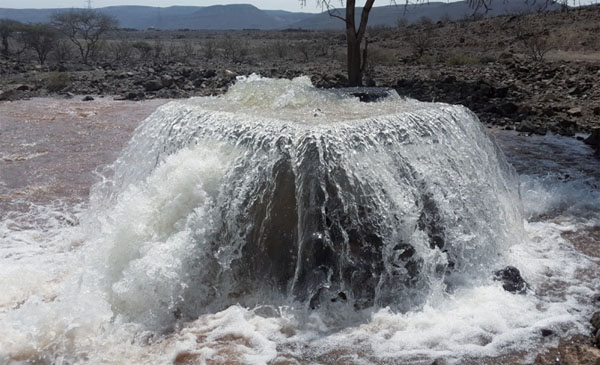
Testing water supply piping system
The “Boiling Pot” Is No Longer Parched
Although the idea of cross-border water supply was promising, there were a lot of unexpected problems during its implementation.
One day in April 2017, Li Zhen, manager of the project, came to work at 8 a.m. excited and nervous because he was about to take an important “test”. The project, then near completion, was to undergo flushing to remove sediments from the water and test water supply. The result would determine whether the people of Djibouti would get clean drinking water.
To run the test, the water pipeline, which was more than 300 kilometers long, was divided into several sections for water supply, pressure test, flushing and disinfection one by one. After being cleaned for several hours, the water was allowed to flow into the next section. In this way, it took nearly two days to clean the water in the first section from the well area to the Kullen pumping station.
During those days, Li Zhen worked from 8 a.m. to midnight almost every day. He intently watched the water flow marked on the map move along the pipeline section by section, waiting excitedly for the beeps that would sound every 30 minutes, signaling that the duty officers in each position in the work group were routinely reporting the arrival of the water flow and the status of pipeline flushing and pipeline safety.
In May, when the water flow was approaching the border between Ethiopia and Djibouti, the 2-kilometer main pipeline, which had not yet been reinforced, was destroyed by a sudden rainstorm in the town of Arta. To ensure that the test across the line remained uninterrupted and the inauguration ceremony, originally scheduled for mid-June, would be held on schedule, Li Zhen urgently dispatched three pipeline construction teams to fix the damaged line by working round the clock. After three days of intensive labor, the broken pipeline was successfully replaced.
“Due to Ethiopia’s rugged terrain, the water transmission line had to traverse across several highlands. It was extremely difficult to transport the water from a low point to a high place,” said an anxious-looking Hussein, employed in Djibouti customs for 30 years. “I had considered it to be an impossible mission until the Chinese company undertook the project.”
Hussein’s concerns were justified. From the official launch of the project to the official handover of the whole water transmission line to the local governments, the construction team raced against time in the scorching sun for over 800 days. The pipeline was over 300 kilometers long, and in addition, there were demanding procedures like lifting the water in three stages when the altitude was low, lowering the water pressure in five stages when it ran too high inside the pipeline, and other complex steps such as manufacturing the pipes, transporting and storing them, and then installing them. One small error in any one of these steps could cause the whole process to break down.
However, the difficulties did not alarm the constructors. With their ability to think outside the box they adopted safe, feasible and economical methods. Finally, excellent construction technology and outstanding construction quality ensured the completion of the project and that the “Water of Happiness” the Djiboutian had been looking forward to arrived at its destination.
On a sunny day in June 2017, hundreds of people gathered to attend the inauguration of the Djibouti cross-border potable water project in Ali Sabieh in Djibouti. They celebrated the completion of the project by singing and dancing around the faucet with the rhythms and beats unique to Africa.
Ismail Omar Guelleh, President of Djibouti, made a speech praising China and Ethiopia for their contribution to the national economy of Djibouti and Djiboutians’ livelihood. After the speech, he invited the Chinese ambassador and the Ethiopian ambassador to Djibouti, government officials and foreign friends to come near the faucet. When he turned it on, a stream of clear water gushed out and seeing it, the president beamed with satisfaction.
It was a historic moment!
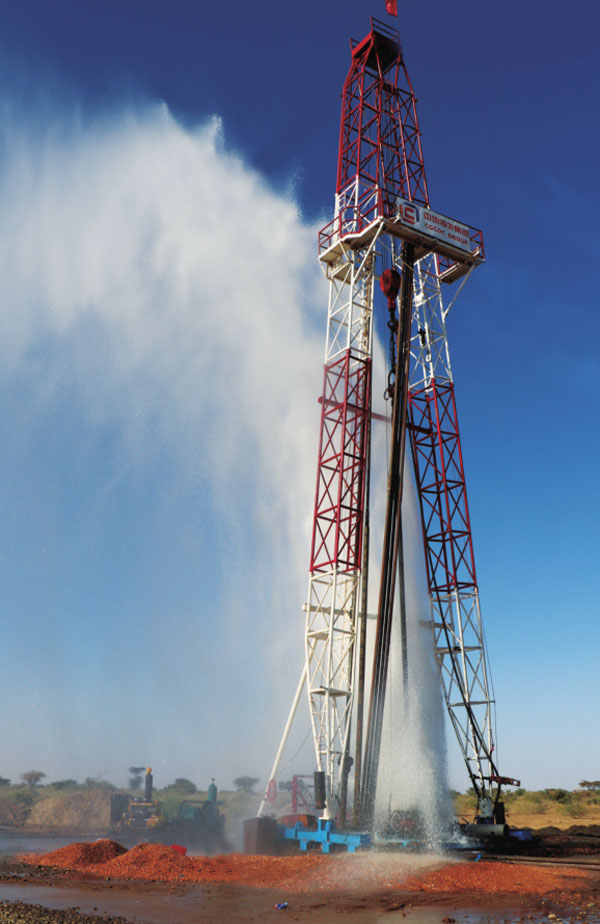
Testing a new well
In addition to daily water for urban residents in Djibouti, the project will also provide water for enterprises to promote the economic development of Djibouti.
The goal of Djibouti’s development strategy, Vision 2035, is to build a regional shipping center and business hub, and enter the ranks of middle-income countries. Thanks to the water supply project, the “Boiling Pot” is no longer parched and a promising picture of economic development is slowly unfolding. Vision 2035 is turning into reality.
Friendship Across Borders
Ethiopia is known as the “Water Tower of East Africa” due to its numerous lakes. However, because of the lack of technical support, it is not easy to make real use of the water even though it is accessible. For instance, even in the low-lying Kullen Valley area where there is plenty of groundwater, it is difficult for the local people to get water. To work this out, the project team specially set up four water points in the Ethiopian section of the water pipeline so that the local residents would get water.
Aden, who lives in the town of Dewele, is one of the beneficiaries.
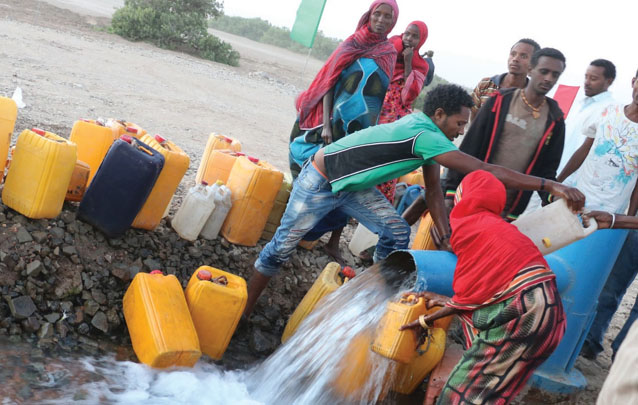
A water point in the desert
Dewele, located on the border between Ethiopia and Djibouti, is overrun by a sprawling desert. People who have lived here for generations have become accustomed to riding long distances on donkeys to fetch daily drinking water for their families and livestock.
But since a water point was set up in Dewele, Aden no longer has to worry about getting water. Her daughter wrote an essay, “Donkeys in Dewele are laughing in relief ”. While the writing style may not be mature, it still reflects the sense of well-being the local people have thanks to the water supply project.
There are many more changes.
Ahmed, a young herder, used to graze his cattle wherever he could find water and grass. In the past, the rains were the only way to water crops. While some corn could be grown in the rainy season, nothing grew in the dry season. But now with water from the pumping station, Ahmed has started a small farm with six friends. They plant watermelons in the first half of the year and onions in the second half, which has improved their income substantially.
Ahmed says the water has wrought a miracle in his life.
In the water point areas in Ethiopia, there are moving stories like “Donkeys in Dewele are laughing in relief ” and “Ahmed’s miracle” every day.
Providing water to the people in their neighboring country has also made Ethiopians beneficiary of the cross-border water supply project. It has proven true the old saying that if you give a rose to others, your hand will smell like a rose.
On Ant Mountain in Ethiopia’s Sumalē State, at an altitude of over 970 meters, lies a 5,000-cubic-meter circular pool. It is the highest point of the cross-border water supply project. From the original source, the transported water passes through this pool, then through Ethiopia to Djibouti.
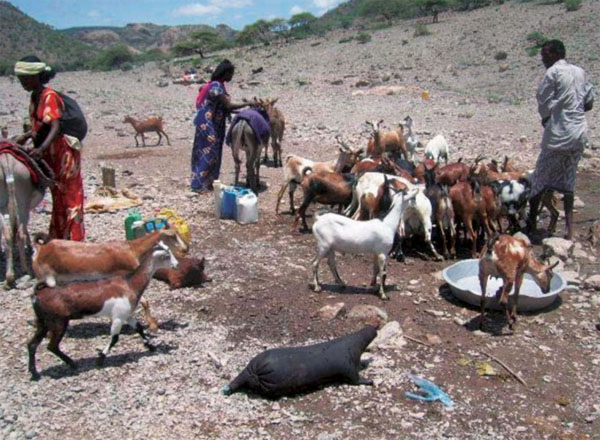
Local people fetching water
This is the “Water of Happiness” that has moistened the dry land and the hearts of the people of Ethiopia and Djibouti. This is also the “Water of Hope”, carrying the yearning of both countries for a stable and prosperous life. And finally, this is also the “Water of Friendship” as it has closely linked the hearts of people with different languages, cultures and skin colors from China, Djibouti and Ethiopia, demonstrating their determination to achieve common development.
FOR MORE
Project Overview
The Ethiopia-Djibouti cross-border water supply project is an East African regional project promoting cooperation between Ethiopia, Djibouti and China. Built by China’s CGCOC Group, the project was completed and officially handed over to the Ethiopian and Djiboutian authorities in June 2017.
The water is drawn from 28 deep wells in Kullen Valley in Ethiopia. After disinfection, the water is carried across the severely arid region of eastern Ethiopia, followed by the Ali Sabieh region of Djibouti, the Dikhil region, the Arta region and Djibouti City. The total length of the pipeline (including the water distribution pipeline) is about 374 kilometers.
It is currently the largest single water supply project in Africa, integrating advanced technologies including three-stage pressurized pump lift, gravity flow pipeline transportation for over 200 kilometers, remote signal transmission and automatic control, which is unprecedented in Africa.


